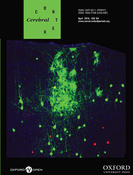Predominance of Movement Speed Over Direction in Neuronal Population Signals of Motor Cortex: Intracranial EEG Data and A Simple Explanatory Model
- Jiří Hammer1,2,3,4,
- Tobias Pistohl2,5,
- Jörg Fischer2,6,
- Pavel Kršek3,
- Martin Tomášek4,
- Petr Marusič4,
- Andreas Schulze-Bonhage1,5,
- Ad Aertsen2,5 and
- Tonio Ball1,5
- 1Epilepsy Center, University Medical Center Freiburg, 79106 Freiburg, Germany
- 2Neurobiology and Biophysics, Faculty of Biology, University of Freiburg, 79104 Freiburg, Germany
- 3Department of Paediatric Neurology, 2nd Faculty of Medicine and Motol University Hospital
- 4Department of Neurology, 2nd Faculty of Medicine and Motol University Hospital, Charles University, 150 06 Prague, Czech Republic
- 5Bernstein Center Freiburg, University of Freiburg, 79104 Freiburg, Germany
- 6CorTec GmbH, 79110 Freiburg, Germany
- Address correspondence to Jiří Hammer. Email: hammer{at}bcf.uni-freiburg.de
Abstract
How neuronal activity of motor cortex is related to movement is a central topic in motor neuroscience. Motor-cortical single neurons are more closely related to hand movement velocity than speed, that is, the magnitude of the (directional) velocity vector. Recently, there is also increasing interest in the representation of movement parameters in neuronal population activity, such as reflected in the intracranial EEG (iEEG). We show that in iEEG, contrasting to what has been previously found on the single neuron level, speed predominates over velocity. The predominant speed representation was present in nearly all iEEG signal features, up to the 600–1000 Hz range. Using a model of motor-cortical signals arising from neuronal populations with realistic single neuron tuning properties, we show how this reversal can be understood as a consequence of increasing population size. Our findings demonstrate that the information profile in large population signals may systematically differ from the single neuron level, a principle that may be helpful in the interpretation of neuronal population signals in general, including, for example, EEG and functional magnetic resonance imaging. Taking advantage of the robust speed population signal may help in developing brain–machine interfaces exploiting population signals.
Key words
- © The Author 2016. Published by Oxford University Press.
This is an Open Access article distributed under the terms of the Creative Commons Attribution Non-Commercial License (http://creativecommons.org/licenses/by-nc/4.0/), which permits non-commercial re-use, distribution, and reproduction in any medium, provided the original work is properly cited. For commercial re-use, please contact journals.permissions@oup.com












